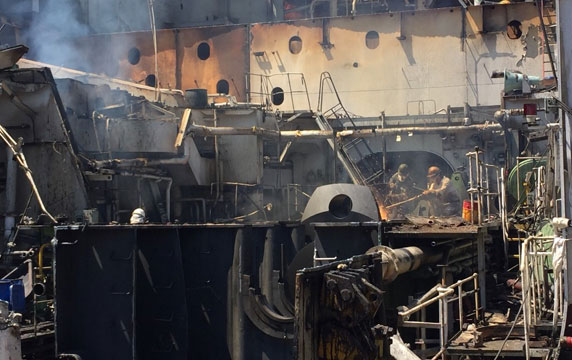Light (displacement tonnage) at the end of the tunnel in recycling business
Shipbreaking activity has slowed significantly in recent years due to high freight rates and geopolitical disruptions. However, the long-term outlook remains positive with the implementation of the Hong Kong Convention in 2025, which is expected to boost green ship recycling.

Read the article at LinkedIn,
https://www.linkedin.com/pulse/light-displacement-tonnage-end-tunnel-recycling-rakesh-bhargava-w6s8f/
Shipbreaking activity has been languishing over the past three years as a boom in freight rates across most segments, largely due to geopolitical factors, has stalled the disposal of older tonnage. But the longer-term market fundamentals remain promising for green ship recycling, with implementation of the Hong Kong Convention (HKC) this year signalling a watershed moment for the sector.
The number of ships delivered to recyclers worldwide was only around 275 last year, similar to the low levels seen in 2023 and 2022. Scrapping demand has been hit by Red Sea diversions due to Houthi attacks and Russia’s war in Ukraine that have kept many ageing container ships and crude tankers in operation.
This has impacted capacity utilization for yards in the major South Asian ship recycling nations of India, Bangladesh and Pakistan. Among those hardest hit are over 120 yards in the Alang region of India that have invested heavily in green recycling facilities to gain HKC compliance, with only 20% of these reported to be currently operational and usually working at less than 50% capacity.
Steel market challenge
The economic situation for these yards has been exacerbated by cheaper imported steel from China that has hit local market demand for recycled steel in South Asian countries, which account for around 85% of global ship recycling. This has led to lower prices offered for tonnage by regional yards, with average recycling price levels falling over the past year by nearly $150 per light displacement tonne (LDT) to around $450/LDT.
The market situation has been compounded by a strengthening of the US dollar against South Asian currencies, as well as other issues such as political instability in Bangladesh and an ongoing wrangle over IMF funding in Pakistan, while the jury is out on the likely business impact of the incoming Trump administration in the US amid protectionist posturing.
But, against this backdrop, there are also positive developments afoot with more yards in Bangladesh and Pakistan upgrading their facilities in pursuit of HKC compliance, despite adverse conditions, in anticipation of a market turnaround.
Turning of the tide
Indeed, there are already signs that the tide is turning with the recently reported sale of the first VLCC for recycling since August 2022. Furthermore, brokerage Fearnleys expects more steam-turbine LNG carriers to be recycled this year after a record eight demolitions in 2024.
The advent of the HKC, set to come into force on 26 June, will precipitate a significant market shift by creating a level playing field that will effectively render non-compliant yards uncompetitive, making it imperative for yards to upgrade to remain in business. Interestingly, recent scrap sales indicate the price differential with green recycling has already been substantially erased.
As well as raising safety and environmental standards, the HKC represents a commercial opportunity for those yards that have put in the legwork to achieve compliance and established competence in green recycling amid an expected future deluge of tonnage set to be put to the torch over the coming years due to the pressing need for renewal of the global fleet in line with decarbonization.
Regulatory drivers for recycling
This is being driven largely by new regulations, such as the EU Emissions Trading System and FuelEU Maritime, that have made it more costly to run pollutive ships by putting a price on GHG emissions, towards the IMO goal of net zero by 2050 as the global maritime body is set to discuss a proposed carbon levy at its next MEPC meeting later this year.
The HKC represents a commercial opportunity for those yards that have put in the legwork to achieve compliance and established competence in green recycling
Cash buyer Wirana expects more containerships, LNG and vehicle carriers to be sent for recycling in the next two years due to substantial upcoming newbuild deliveries in these segments.
There is also further demand upside for recycling yards with increasing interest in so-called ‘green steel’ produced from recycled steel in induction furnaces that generates relatively low CO2 emissions, versus new steel produced from iron ore using high-carbon blast furnaces. Ultimately, the use of green steel could also be factored into the ESG reporting of shipping companies to incentivize shipbreaking.
Reaping green rewards
Green recycling has been given a further boost with the recent launch by Bimco of a Ship Recycling Alliance including recycling associations in India, Pakistan, Bangladesh and Turkey, along with cash buyers, intended to promote HKC compliance in these countries to provide the necessary capacity boost for an estimated 15,000 ships expected to be recycled over the next 10 years.
So, while current market dynamics may have hit profitability in the shipbreaking business, payback time is surely in sight for those yards that have made the required investments in sustainable recycling facilities to cope with future demand.
Sea Sentinels has specialist expertise and long experience in safe and sustainable recycling of marine assets and can manage every step of the recycling process from benchmarking and vetting of yards and inventory of hazardous materials to independent on-site monitoring by expert and experienced personnel to ensure compliance with regulations, with auditable reporting to verify compliance.
For more information, contact:

Rakesh Bhargava, CEO
Sea Sentinels
Email: Rakesh.Bhargava@sea-sentinels.com
Tel: +60 12 215 0137

